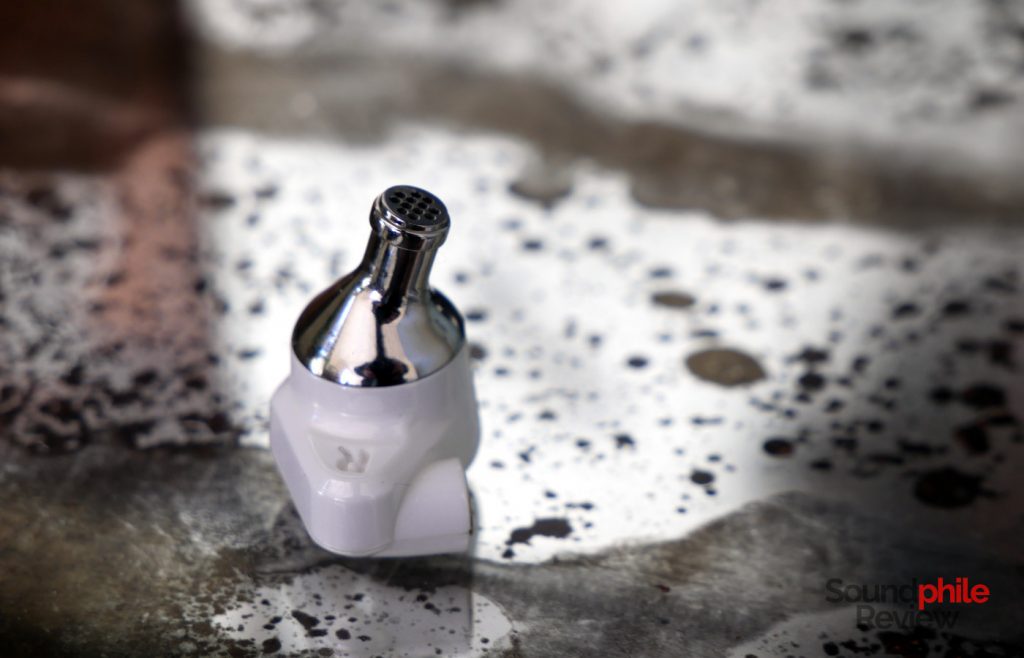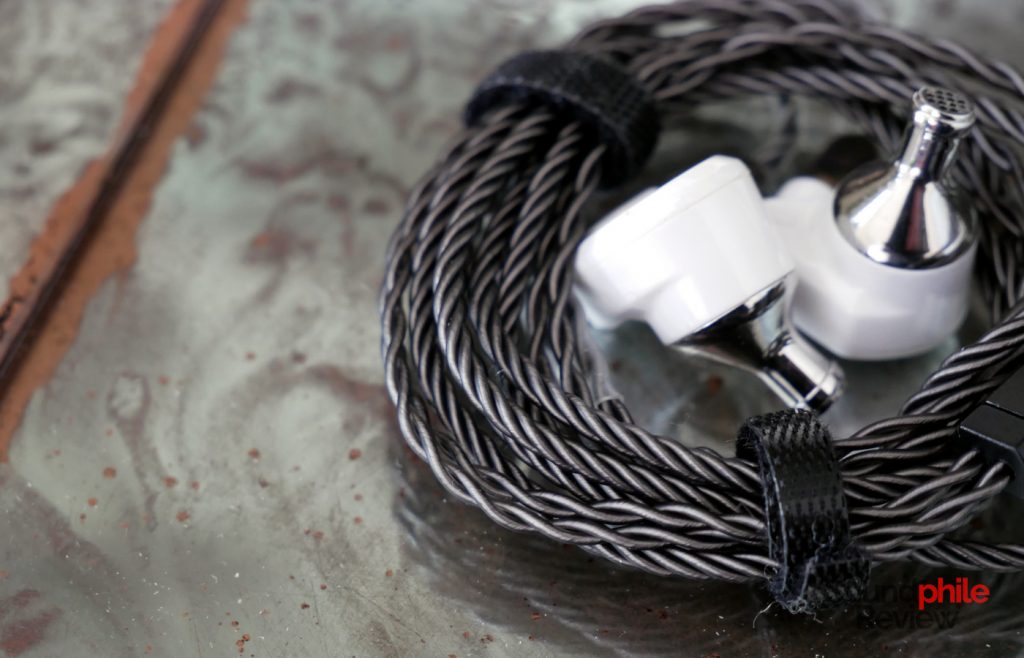Campfire Audio’s return to the Vega, a design which has earned them quite some fame, was marked by a change in a few key areas that make the new Campfire Audio Vega 2020 quite different from the original model. While many things are the same – the general shape of the shell, the use of a single dynamic driver using the ADLC technology, the aim for fun – there are many new things that make this new edition stand out on its own as a fun, relaxing earphone to take you on your musical journeys.
Disclaimer: John at KS Distribution, whom I thank, provided the sample for this review. The Vega 2020 sell for £/$ 900.
TL;DR: recap
| Pros |
Cons |
| + Superbly built and designed
+ Extremely comfortable + Excellent detail retrieval and clarity + Relaxed sound signature |
– Recessed midrange
– Bass can be excessive |
Rating: 8/10
Packaging & Accessories

Campfire Audio included quite a lot of accessories with the Vega 2020. Inside a green fabric pouch are the earphones with their removable cable, a small brush and a really wide range of eartips which includes three sizes of eartips made of foam and (single-flange) silicone, plus five sizes of single-flange silicone tips made by Final. The earpieces are stored inside a small bag made of net with two compartments, one pear earpiece, and the cable is held together with two Velcro straps. There are two other bags made of net to hold the various eartips.
The zip bag is small enough to fit in the pockets of most trousers, yet it is large enough to hold the earphones and all of their accessories (though you have to cram them into it a bit). The inside is lined with a fluffy wool-like synthetic material that feels soft. It appears durable and really well-made, with a golden zip and a small plaque with the Campfire Audio logo on the front.
Design & Comfort

The Campfire Audio Vega 2020’s shell is very small and looks like the child of a triangle and a circle – basically like a wedge with a very rounded side. It’s white and glossy as it is made of ceramic, which undergoes the same lengthy production process as the Dorado 2020: to make it short, it spends a crazy amount of time at crazy temperatures (up to 1200 degrees! Though I wonder if it’s Fahrenheit or Celsius…). The nozzle is made of stainless steel and it is silvery in colour. It’s a very simple design, but one which I quite like because of that.

I find the Vega 2020 to be exceptionally well built, with a lot of attention to all the parts fitting perfectly. You can really tell how much effort Campfire Audio did put in the building process. partly because of this, and partly because of the materials used, the Vega 2020 look and feel quite durable and resistant; the company says the ceramic is especially resistant to scratches, though I didn’t test this claim for obvious reasons.

Comfort is quite great and if it is for me, you can bet it will be for you as well. My very sensitive skin vouches for that. It’s a matter of shape and size: being small and without any sharp edges, the earpieces of the Vega 2020 fit inside my ear basically without touching anywhere and therefore without causing any pressure, so they turn out to be quite comfortable.

It might be because of the ceramic shell, but the Vega 2020 offer quite a good amount of passive isolation. They are good enough to shield you from noises even on the streets, so indoors you should feel quite quiet (sorry, I had to do that.). Any moderately loud sound will probably be kept at bay, allowing you to concentrate on the music.

The Vega 2020 comes with the standard Campfire Audio copper litz cable: four cores, twisted all together between the jack and the Y-split, then twisted in couples. Each core has a dark grey plastic sleeve. The cable as a whole is very soft and malleable, with very little microphonics that make it possible to use it also while being out and about. One thing I’m not especially fond of with Campfire Audio earphones is the thickness, though. Although I suspect there are technical reasons for it, I still find it underwhelming from a “look and feel” perspective – not because of a cosmetic preference, but because if it was a tad thicker it would inspire more confidence in its ability to resist wear & tear. Still, it works quite well and is very comfortable even to people who wear glasses like me, so there’s not too much room for complaint here.
I’m usually not really a fan of MMCX connectors because they’re harder to insert and remove than 2-pin connectors, plus they are a lot less durable. Campfire Audio tried to remedy that by using beryllium-coated copper MMCX connectors, which should provide much better durability compared to the usual ones made of brass.
Sound
I tested the Campfire Audio Vega 2020 using mostly a Topping DX7 as DAC and a Drop THX AAA 789 as amplifier. Most music files were FLACs ripped from CDs.
Campfire Audio Vega 2020 |
| Frequency response | 5 – 22,000 Hz |
| Impedance | 36 Ω |
| Sensitivity | 94 dB |
Campfire’s own ADLC driver is the only one used in the Vega 2020. It’s a dynamic driver coated with “amorphous diamond-like carbon”, which is basically a coating to make the diaphragm super stiff and therefore improve its acoustic qualities (a stiffer driver is usually equivalent to less driver flex and, in turn, to more detail and less distortion). This is not the same as the one used for the Dorado 2020, but it’s quite close and uses the same tech.
The Vega 2020 have an impedance of 36 Ω and a sensitivity of 94 dB, so you shouldn’t need any special source to drive them. In fact this is a rather easy to drive earphone, which should be totally fine with whatever source you use but for one detail: output impedance. It is fundamental that you use a source with very low output impedance, ideally inferior to 1 Ω (though anything less than 4 Ω should be fine). Most products not made with audio reproduction as their first use case, e.g. laptops or smartphones, have higher output impedance. In theory you don’t need any specialised device to drive them: any phone, laptop or tablet is more than capable of providing power for them, but they don’t have a low enough output impedance and this can influence the sound of the Vega 2020. While this may not be entirely bad (or even unwanted, up to a certain point), it’s generally better to use something with a low output impedance.
Soundstage has good width, but poor depth, and it never managed to give me the impression that music was actually happening outside of my ear canals – in fact I always got the impression that it was happening inside my head. Imaging is therefore not that great from this perspective, nor from the one of having a variety of positions going from left to right (and vice-versa); on the other hand, it is good at placing each instrument in its own little space. There’s a very good instrument separation, with good detail retrieval even in crowded tracks.
The Vega 2020 has abundant, strong bass that is a ton of fun to listen to, but which can sometimes be a tad too much. What I love about it is that it reaches quite deep, giving you that strong kick that makes music more fun and certainly more entertaining, and it’s quite fast an impactful, with a strong sense of physicality that hits and transports you. It makes drums and other percussion instruments quite realistic, also thanks to the relatively short decay (which is not too short, though, and that’s what makes the difference: it’s just about right). I also quite like the fact that bass is coherent and wanes from the high of sub-bass to the lowest point, well into midrange territory, without any bumps or dips. You can hear that because there’s no prevailing part, nor any sense of fatigue; the issue is, though, that it is still emphasised and sometimes can become a bit excessive, masking the lower mids. There are a lot of micro-details that emerge clearly and layering is very good as well.
Just like the Dorado 2020, the Vega 2020 also has quite a weird midrange: it is recessed and sometimes hard to reach, especially in the region around 1 kHz – which is, incidentally, fundamental to get the right tonality. The Vega 2020 have emphasised lower mids, recessed middle mids (sorry about that) and then slightly emphasised upper mids; this leads to a weird tonality that doesn’t sound bad, but which is quite selective in what kinds of music sound properly right. Voices are a bit distant and with a slightly off tonality, while some instruments like violins and flutes can be a bit harsh at times. Overall, though, the listening experience is quite relaxing and easy on the ears, with a warm tonality that will surely please many. There is a very good level of detail, with micro-details being showcased clearly, and the same physicality as the bass region.
Treble is quite relaxing, as it is rendered with clarity but without major peaks that would make it fatiguing. It has its largest presence around 6 kHz, then there’s another peak around 10 kHz, and then it rapidly wanes after that leaving the upmost region empty. It is the kind of treble that sensitive folks will appreciate, as it delivers enough substance to be clearly heard and to showcase a good amount of detail, yet it mostly stays out of the way, letting you concentrate on what’s happening at lower frequencies. It’s got a fine level of detail and sounds rather fine-grained, but it lacks the finesse of earphones with a more linear response.
Campfire Audio Dorado 2020 Comparisons
The Campfire Audio Vega 2020 are basically a more laid-back and warmer version of the already warm Dorado 2020 which come without the hot treble and with a more balanced, but also slightly more recessed, midrange. Everything else is virtually the same, but I found the Vega 2020 to be more relaxing and easier to listen because of the lower peaks in the treble region. The Dorado 2020 is basically a more energetic Vega 2020, so the decision on which one to choose should ultimately depend on which style you prefer.
Final Thoughts
I am usually more for earphones that reproduce music in a neutral, analytic – some may say even boring – fashion, because I think that’s the closest you can get to the original thing. That’s a bit like my preference for plain tea: I would much rather drink plain, “boring” black tea than a blend with lots of flavourings in it. There are exceptions, though: sometimes I have a craving for a good cup of chai or Earl Grey (which I am drinking right now as I write this!) and I really enjoy those moments. It works like that with audio as well: as much as I like plain, neutral earphones, I also enjoy a bit of flavouring from time to time and earphones like the Campfire Audio Vega 2020 provide that with exceptional quality.
They’re especially great as a companion to other, more neutral earphones for those times when you just want that additional punch and fun – basically, for when you just want to relax without caring too much about how music should idealistically sound. They’re really great at delivering a relaxed, laid-back listening experience that will make you just want to close your eyes, lay back and enjoy the music, oblivious to everything else.








